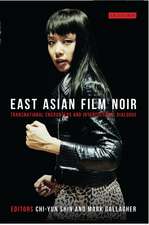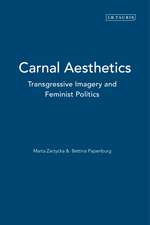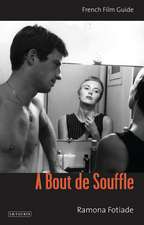'Russian Americans' in Soviet Film: Cinematic Dialogues Between the US and the USSR: KINO - The Russian and Soviet Cinema
Autor Marina L. Levitinaen Limba Engleză Paperback – 16 sep 2020
| Toate formatele și edițiile | Preț | Express |
|---|---|---|
| Paperback (1) | 225.12 lei 6-8 săpt. | |
| Bloomsbury Publishing – 16 sep 2020 | 225.12 lei 6-8 săpt. | |
| Hardback (1) | 774.13 lei 6-8 săpt. | |
| Bloomsbury Publishing – 24 sep 2015 | 774.13 lei 6-8 săpt. |
Din seria KINO - The Russian and Soviet Cinema
- 13%
 Preț: 168.15 lei
Preț: 168.15 lei - 23%
 Preț: 192.01 lei
Preț: 192.01 lei - 23%
 Preț: 191.13 lei
Preț: 191.13 lei - 30%
 Preț: 511.31 lei
Preț: 511.31 lei - 10%
 Preț: 174.37 lei
Preț: 174.37 lei - 18%
 Preț: 167.46 lei
Preț: 167.46 lei - 10%
 Preț: 171.73 lei
Preț: 171.73 lei - 19%
 Preț: 179.35 lei
Preț: 179.35 lei - 30%
 Preț: 509.52 lei
Preț: 509.52 lei - 19%
 Preț: 170.95 lei
Preț: 170.95 lei - 30%
 Preț: 773.45 lei
Preț: 773.45 lei - 18%
 Preț: 173.08 lei
Preț: 173.08 lei - 10%
 Preț: 168.22 lei
Preț: 168.22 lei - 30%
 Preț: 773.81 lei
Preț: 773.81 lei - 21%
 Preț: 217.82 lei
Preț: 217.82 lei - 21%
 Preț: 218.18 lei
Preț: 218.18 lei - 18%
 Preț: 169.48 lei
Preț: 169.48 lei
Preț: 225.12 lei
Preț vechi: 289.08 lei
-22% Nou
Puncte Express: 338
Preț estimativ în valută:
43.08€ • 44.97$ • 35.65£
43.08€ • 44.97$ • 35.65£
Carte tipărită la comandă
Livrare economică 05-19 aprilie
Preluare comenzi: 021 569.72.76
Specificații
ISBN-13: 9781350200050
ISBN-10: 1350200050
Pagini: 336
Ilustrații: 21 bw integrated
Dimensiuni: 138 x 216 mm
Greutate: 0.39 kg
Editura: Bloomsbury Publishing
Colecția Bloomsbury Academic
Seria KINO - The Russian and Soviet Cinema
Locul publicării:London, United Kingdom
ISBN-10: 1350200050
Pagini: 336
Ilustrații: 21 bw integrated
Dimensiuni: 138 x 216 mm
Greutate: 0.39 kg
Editura: Bloomsbury Publishing
Colecția Bloomsbury Academic
Seria KINO - The Russian and Soviet Cinema
Locul publicării:London, United Kingdom
Notă biografică
Marina Levitina teaches Russian Cinema and Russian Cultural Studies at Trinity College, University of Dublin. Her research interests include early Soviet cinema and culture, the cinema of Andrei Tarkovsky and cinema and memory. She is also a documentary filmmaker.
Cuprins
IntroductionI. Sources and ModelsII. American Cinema as the Source of the 'Russian American' New Soviet Man ModelIII. The 'Crucified' and the 'Glorified' New ManIV. Contribution to the FieldV. MethodologyChapter 1. Popularity of American Films and Stars in Soviet Russia in the 1920sI. Before and After 1917: 'Daredevil' Pearl White through Russian EyesII. After 1922: Soviet Reception of American FilmsIII. Avant-garde Filmmakers' Response to American CinemaIV. Douglas Fairbanks as the Prototype of the Positive Hero of Socialist Realist CinemaChapter 2. Americans and 'Russian Americans' on the Screen in the 1920s: Cinematic and Literary ConnectionsI. 'Red Pinkertons': The Effects of the American Adventure Genre on Portrayals of the New Soviet ManII. 'Russian American' New Soviet Man in 'Novyi Byt' Films of the Late 1920sIII. Representations of Americans in Soviet Films with Contemporary ThemesIV. Representations of Americans in Soviet Film Adaptations of American LiteratureChapter 3. New Soviet Woman in the Cinema of the 1920sI. Reality and Transformation of a Soviet WomanII. American Models of New Femininity in Early Soviet Films III. From the 1920s to the 1930s: the Shift in Policy and RepresentationChapter 4. 'Americanized' New Soviet Woman on the Screen in the 1930s and early 1940sI. From Multiple Models of Femininity in the 1920s to the Unified Model of the 1930sII. Liubov' Orlova: Pickfordian Femininity and the 'Russian American' IdealIII. The New Soviet Woman in The Shining Path (1940)IV. Ianina Zheimo: Another Soviet Pickford?Chapter 5. 'Americanized' New Soviet Man in Films of the 1930s and early 1940sI. The New OptimismII. Fitness and Fame: Sportsmen HeroesIII. Mastery over Technology: Engineers-Inventors IV. Efficiency and Rationalization of LabourV. Trailblazers in the Skies: The Cult of the Aviator HeroConclusionI. American Film Actor: The 'Brick and Cement' for Constructing Soviet CinemaII. 'Americanization of Personality'III. 1930s: Human Beings of a Superior KindIV. 'Americanness' at the Root of 'Sovietness'?AppendixFilmographyBibliography
Recenzii
The book is so informative, engaging, and accessible that it deserves a readership that extends beyond the relatively small circle of Soviet cinephiles to scholars and and students of Soviet culture, Russian-American relations, gender studies, and American silent film. Highly recommended.










